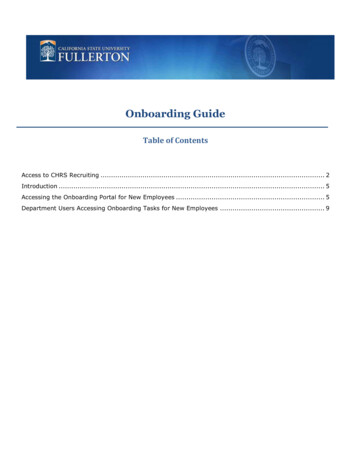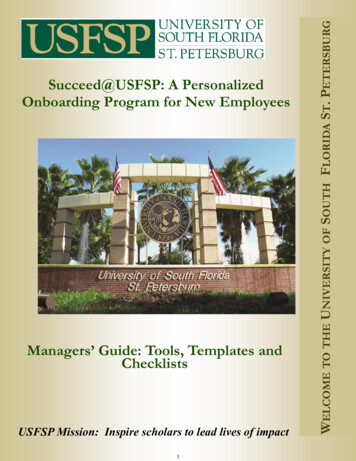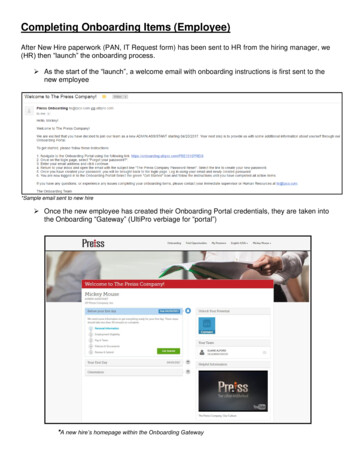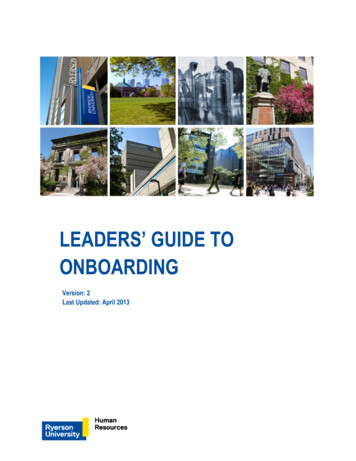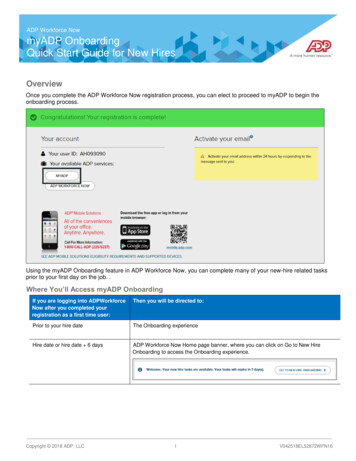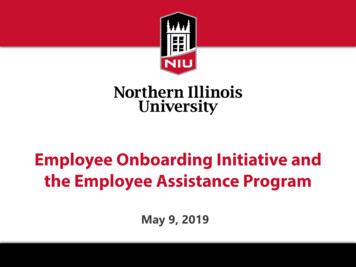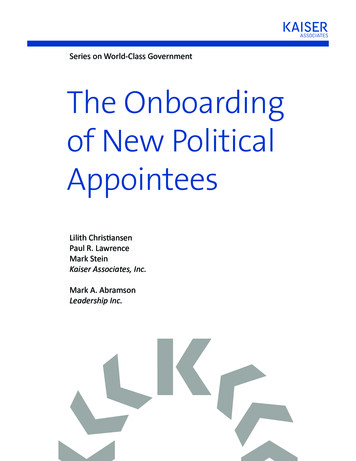
Transcription
Series on World-Class GovernmentThe Onboardingof New PoliticalAppointeesLilith ChristiansenPaul R. LawrenceMark SteinKaiser Associates, Inc.Mark A. AbramsonLeadership Inc.
ForewordOn behalf of Kaiser Associates, Inc., we are pleased to release the first in our newseries on world-class government. The series is based on the premise that worldclass government is indeed possible and that there are many best practices frompublic, private, and nonprofit organizations that can be applied in the federalgovernment.As our first paper in the new series, we selected the timely topic of onboardingnew political appointees in the new administration. We feel it is crucial that thenew administration quickly develops an onboarding program to prepare newappointees for the challenges of managing in government. This report presentsa series of recommendations for actions needed to implement an onboardingprogram.The report builds on prior research by my Kaiser Associates colleagues. MarkStein and Lilith Christiansen conducted extensive research on onboarding fortheir book Successful Onboarding: A Strategy to Unlock Hidden Value WithinYour Organization. Our new Kaiser colleague Paul Lawrence recently co-authoredSucceeding as a Political Executive: 50 Insights from Experience, which is basedon interviews with Obama Administration political appointees. Paul and hisco-author Mark Abramson found that nearly all those interviewed expressed aneed for better preparation prior to assuming their new positions.In this report, we highlight the Department of State’s method as a best practicefor onboarding. By finding best practices in this and all sectors, there are manymodels for effective onboarding from which the new administration can drawupon. We trust that this report will be helpful in implementing an onboardingprogram for new appointees in 2017.Joseph GurneyLeader, Public Sector Practice and Senior Vice PresidentKaiser Associates, TES.COM 2016 KAISER ASSOCIATES, INC.
Table of ContentsiiForewordivReport Abstract1Part I — Introduction: The Need to Prepare Political Appointees5Part II — Best Practices in Onboarding Political Appointees:The Department of State10Part III — What We Learned About Implementing Onboarding forNew Appointees12Part IV — Recommendations on Implementing Onboardingfor New Political Appointees18Key Contact Information19About the Authorsiii 2016 KAISER ASSOCIATES, INCKAISERASSOCIATES.COM
Report AbstractFINDINGSFinding One: Based on interviews with 65 high-levelappointees in the Obama Administration over the lastseven years and follow-up interviews and research, wefound few examples of organized, sustained efforts toprovide onboarding to political appointees.Finding Two: Nearly all of the political appointees interviewed during previous research felt that they neededonboarding support, which they did not receive.Finding Three: The time period between the nominationof an appointee and his or her confirmation should beused to start the onboarding process.Finding Four: A sustained, organized effort to onboardall political appointees will face several distinct challenges.RECOMMENDATIONSRecommendation One: Each department should createa unit dedicated to providing onboarding support tonew political appointees.Recommendation Two: The Deputy Secretary of eachdepartment should be responsible for oversight of theonboarding of all political appointees.Recommendation Three: The onboarding unit, overseenby the Deputy Secretary, should develop an individual onboarding plan for each new political appointee.Onboarding services should be offered on a rolling basis.Recommendation Four: Onboarding activities shouldbegin shortly after the White House submits an appointee’s nomination to Congress and continue throughoutthe first year of service.WHAT SHOULD POLITICAL APPOINTEES KNOW?The information needs of political appointees are great and include: The Basics (How do I become an employee of the federal government?) The Essentials (What are the rules of government that I need to know?) The Job (What do I need to know about my job?) Becoming Effective (How do I succeed in my job?)ivKAISERASSOCIATES.COM 2016 KAISER ASSOCIATES, INC.
Part IIntroduction: The Need to Prepare Political AppointeesPREMISES OF REPORTThis report is based, in part, on interviews with 65top-level appointees in the Obama Administration fromthe start of the administration in 2009 to its final yearin 2016.1 Many of these appointees were interviewedmultiple times to track their “learning curve” and tounderstand the challenges of managing in the federalgovernment. Additional interviews were conductedin September and October 2016 with federal officialsknowledgeable about the onboarding of politicalappointees.In addition to the interviews, three literaturereviews were conducted. The first review examined literature on onboarding in the private sector. The secondreview examined academic research on the politicalappointments process and previous efforts to preparenew appointees. The third review examined recentreports on the federal government’s activities in thearea of onboarding senior executives.Based on the interviews and research, the authorsdecided to prepare this report calling for better preparation of new political appointees as a new administrationtakes office. We believe that an onboarding programfor new political appointees will greatly enhance theeffectiveness of new appointees in implementing thepriorities and programs of a new administration.This report is based on the following three premises: Political appointees do not receive adequatepreparation for assuming their new positions. This premise is based on the results of the seven-year longitudinal study of political appointees, cited above, in which nearly all of theappointees interviewed expressed a clear needfor more preparation. The need for adequatepreparation is crucial because of the relativelyshort tenure of many appointees. Given thereality that many appointees will not get confirmed until the third or fourth quarter of 2017,many will, at best, serve no more than the finalthree years of the first term. Considering that,it is crucial to speed up the learning curve ofappointees in order to enhance their effectiveness during their tenure.There are best practices in onboarding in theprivate sector that can be deployed to betterprepare new appointees. In the private sector,great effort is devoted to onboarding new executives (as well as junior staff) who are joining anorganization. In advocating the use of privatesector onboarding practices in governmentin their report “Making Senior GovernmentService More Attractive,” Business Executivesfor National Security (BENS) writes, “CorporateAmerica views executive onboarding as a keyenabler of corporate success and strives toensure that its leadership is prepped and readyto assume the demands of the job as rapidlyas possible. Private sector best practice is to1. For additional information on the interviews, see Paul R. Lawrence and Mark A. Abramson, Succeeding as a Political Executive: 50 Insightsfrom Experience (Lanham: Rowman & Littlefield, 2016).1 2016 KAISER ASSOCIATES, INCKAISERASSOCIATES.COM
THE ONBOARDING OF NEW POLITICAL APPOINTEES establish comprehensive, thorough onboardingprocesses focused on providing relevant information in a structured methodology .”2By implementing onboarding activities for newappointees, the new administration will significantly benefit from the enhanced effectivenessof its new appointees. Given the need to movequickly on executing the new administration’sagenda shortly after the inauguration, newappointees must rapidly learn about their neworganization and managing in government. Bydevoting sufficient resources to onboarding newappointees during the first year of the administration, new appointees will be more effective intheir new positions to execute the administration’s policies and programs.WHAT IS ONBOARDING?In the context of the federal government, onboardingis often confused with “orientation” programs for newappointees, but onboarding is much more. In short,onboarding is an ongoing series of activities aimed atproviding new political appointees with the information,insights, and perspectives they need to become effective executives in government. In contrast, orientationis usually a one-time event (ranging in length from ahalf day to a full day) with no follow-up or additionalongoing activities. While a “White House Orientation”program (an event planned and sponsored by the WhiteHouse Office of Presidential Personnel) has long beenadvocated by the public management community, thisone-time orientation activity has been sporadically heldby past administrations and often held (if at all) late inthe first year of an administration. Even when held, wehave found that a half-day or full-day session cannotprovide new appointees with all the preparation theyneed in a timely fashion.While there are many definitions of onboarding, wewill use the following definition in this report: “Strategiconboarding is a systemic and designed approach overthe first year of an appointee’s tenure that will preparehim or her for success. The goal of strategic onboardingis to have new appointees become productive in a shortamount of time.”3 In the private sector, onboardingoften refers to acquiring, accommodating, assimilating,and accelerating new leaders into the organization’sculture and business. In the context of the federal government, onboarding includes providing information ina variety of areas, as well as providing insights on howto be an effective manager.THE NEED FOR ONBOARDING: THE UNFINISHEDJOURNEY TO ONBOARDING NEW POLITICALAPPOINTEESInsights and Recommendations from the PublicManagement CommunityThe case for an effective onboarding program wasmade by Professor James Pfiffner as part of the politicalappointee project conducted by the National Academyof Public Administration in the 1980s. Pfiffner proposedthe following scenario:Is this a plausible scenario? A majorenterprise in the United States regularlyhires new senior executives for positionswith enormous management and policydevelopment responsibilities. But, oddly,60 percent of the people it hires are notcurrently in the same line of work as theenterprise, and 20 percent have neverbeen in that line of work before. Oncehired, they immediately assume theauthority and responsibilities of their newpositions, but only one in five receives anyformal orientation to the new environment or new duties.No major corporation would operatethis way, nor would a university or lawfirm. Indeed, in all of American society,there is only one enterprise that treats socarelessly the recruitment and orientationof its top executives: the United Statesgovernment.42. Business Executives for National Security, Making Senior Government Service More Attractive, Washington, DC: May 2015.3. This definition is adapted from Mark A. Stein and Lilith Christiansen, Successful Onboarding: A Strategy to Unlock Hidden Value WithinYour Organization (New York: McGraw Hill, 2010)4. James P. Pfiffner, “Strangers in a Strange Land: Orienting New Presidential Appointees,” in G. Calvin Mackenzie, The In-and-Outers:Presidential Appointees and Transient Government in Washington (Baltimore: Johns Hopkins Press, 1987), Page 141.2KAISERASSOCIATES.COM 2016 KAISER ASSOCIATES, INC.
THE ONBOARDING OF NEW POLITICAL APPOINTEESThe public management community has long advocated more preparation for political appointees. In 1989,the Volcker Commission wrote: [A]ll presidential appointees must receiveadequate orientation to office. Suchorientation should be provided during thehiatus between nomination and confirmation, focusing on the substantive policy andadministrative responsibilities each appointee faces, the ethical conduct expected ofpublic officials, and the positive role thatcareer officers can play.5Over 20 years (and four administrations) later, thePartnership for Public Service identified the same set ofconcerns in 2010. The Partnership wrote:Too little attention is paid—and insufficient resources are devoted—to preparing and training political appointees.Many political appointees are policyexperts, but the success of those policiesmay depend on how well they are able tomanage and lead the career civil servantswho most carry out the mission. The newleadership needs to prioritize selectingand preparing its team to govern.6Insights from Political Appointees ThemselvesDuring the seven-year study cited earlier, intervieweesreflected that onboarding was needed to better preparethem for their new positions. Interviewees recalled:“I wish there had been an orientationprogram. I could have used a one-weekseminar. That would have been very helpful. The orientation would tell us how tonavigate in Washington, including workingwith the Hill.”— Dennis Hightower, former DeputySecretary, Department of Commerce“I felt like an outsider. I had only beenin this building twice before. I felt that Iwas largely on my own. Didn’t get a lot ofguidance. I think I needed a boot campabout Congress: Hill 101. I also needed tounderstand the budget process, humanresources, and procurement.”— John Porcari, former Deputy Secretary,Department of TransportationIn addition to the interviews cited above, a surveyof political appointees came to the same conclusion.A National Academy of Public Administration surveyin 2008, the last year of the George W. Bush Administration, confirmed that nearly half of all politicalappointees reported that they received no orientation.Of those who did receive orientation, 33 percent ratedthe orientation’s effectiveness as only somewhat (17percent), not very (12.5 percent), or very poor (3.1 percent). In this same survey, over 80 percent said it was“important or very important” to receive onboarding.Most respondents reported they thought that additionalorientation or continuing education was necessary fortheir effectiveness.7The Federal Government Has Recognized theImportance of Onboarding Members of the SeniorExecutive ServiceDuring the same time period in which there appearedto be little interest in the onboarding of new politicalappointees, there was increasing interest in governmentin the onboarding of members of the Senior ExecutiveService (SES). In 2010, the Office of Personnel Management, the Senior Executive Association, and the Partnership for Public Service convened over 100 individuals todiscuss the importance of, and challenges to, onboarding federal senior executives. The conference resulted ina 2011 report called “Hit the Ground Running: Establishing a Model Executive Onboarding Program.”8 The5. Report of the National Commission on the Public Service, Rebuilding the Public Service (Washington, DC: 1989), page 21.6. Partnership for Public Service, Ready to Govern: Improving the Presidential Transition (Washington, DC: 2010), page ii7. G. Edward DeSeve, Speeding up the Learning Curve (Washington, DC: IBM Center for the Business of Government and the NationalAcademy of Public Administration, 2009)8. United States Office of Personnel Management, Hit the Ground Running: Establishing a Model Executive Onboarding Program (Washington, DC: October 2011)3 2016 KAISER ASSOCIATES, INCKAISERASSOCIATES.COM
THE ONBOARDING OF NEW POLITICAL APPOINTEESreport presented a framework and steps for onboardingmembers of the Senior Executive Service, but it onlybriefly acknowledged the need to consider the onboarding needs of political appointees.The federal government’s increased interest in SESonboarding has had several clear results. First, the Officeof Personnel Management established an ExecutiveOnboarding Wiki on the OPM website to assist agenciesin providing onboarding to Senior Executive Servicemembers. Second, the president issued an executiveorder in December 2015 on strengthening the SeniorExecutive Service. The executive order contained thefollowing mandates: Establish a Formal Executive OnboardingProgram. The new program should be informedby OPM’s Enhanced Executive Onboardingand Government-Wide Executive OnboardingFramework. This shall provide critical supportand guidance to executives through their firstyear of service in new positions, consistent withguidance to be issued by OPM no later than60 days after the day of this order. Onboardingshall be provided for career and non-career SES,SL, and ST employees, and for SES-equivalentpositions. Require Executive Ownership of StrategicRecruitment and Hiring. Department DeputySecretaries, or their direct designees, will trackand monitor SES vacancies and recruiting effortson a regular basis, dramatically increasing seniorleadership and attention for recruitment andhiring. This action significantly enhances therole and responsibility of the Deputy Secretaryin overseeing the department’s executive corps,which includes both political executives andcareer executives.Since the executive order was issued, the Department of Veterans Affairs, the Department of Housingand Urban Development, the Peace Corps, and theOffice of Personnel Management have conducted pilotexecutive onboarding programs for members of theSenior Executive Service. Work is now underway toimplement the executive order in other federal departments and agencies for their SES members. To ourknowledge, little work has been done to develop executive onboarding for new political appointees acrossgovernment.4KAISERASSOCIATES.COM 2016 KAISER ASSOCIATES, INC.
Part IIBest Practices in Onboarding Political Appointees:The Department of StateINTRODUCTIONAs noted in the previous section, we searched foronboarding activities within the federal governmentwhich could serve as a model for other departmentsand agencies. Based on our research, we found thatthe Department of State devoted significant resourcesfor onboarding and had assigned lead responsibilityto the Foreign Service Institute (FSI) within the department. The goal of State’s onboarding program, throughboth its formal and informal activities, is to set up newAmbassadors for success. Preparing new Ambassadorsdoes not start on the day they walk into their newoffice, but rather many months prior to their swearingin and assumption of duties.PREPARING AMBASSADORS TO SERVEThe ProcessAll United States Ambassadors, career and non-career,go through five distinct phases of preparation prior tolanding in their country of appointment. The phases are: Phase One: The Vetting Process Phase Two: The Pre-Nomination Phase Phase Three: The White House Announcement Phase Four: The Confirmation Hearing Phase Five: After ConfirmationPhase One: The Vetting ProcessThe first phase is behind-the-scenes work to get candidates selected, agreeing to serve, and then thoroughlyvetted by the White House and the Department ofState. Prior to formal nomination, candidates’ namesare not disclosed, as it is possible for a candidate to notpass the vetting process. Should this happen, neitherthe candidate nor the White House wants to be embarrassed by having to withdraw a name publicly.During Phase One, the candidate may choose toeducate him or herself about the country of appointment and its relationship with the United States throughvarious reading resources. There is no formal preparation offered at this time.Unique to the diplomatic community when choosing Ambassadors is a diplomatic courtesy process calledAgrément. Agrément requires that before a countryappoints a new chief of diplomatic mission to representit in another country, the proposed appointee mustfirst be deemed acceptable to the receiving country.The agreement by the receiving country is signified byit granting its Agrément to the appointment. It is rarefor an Agrément to be refused, but it can happen.9 TheWhite House cannot forward an Ambassador’s nomination to the United States Senate for confirmation (PhaseThree) until the Agrément is completed.Phase Two: The Pre-Nomination PhaseAfter vetting is complete but prior to nomination, candidates can be formally introduced to key personnel onlywithin the Department of State. These meetings andconsultations are where Ambassadors’ education and9. http://www.ediplomat.com/nd/glossary.htm5 2016 KAISER ASSOCIATES, INCKAISERASSOCIATES.COM
THE ONBOARDING OF NEW POLITICAL APPOINTEESPOLITICAL APPOINTEES IN THE DEPARTMENT OF STATEThe Department of State has nearly 400 political appointees. These appointees include: Over 250 Presidential Appointments with Senate Confirmation (PAS). PAS appointees include: Over 190 Ambassadors, the focus of this paper. Approximately 70 percent of Ambassadors comefrom within the career ranks of the Foreign Service. The remaining 30 percent of Ambassadorscome from outside of government and often are referred to as non-career Ambassadors. Bothcareer Foreign Service officers and non-career nominees all require Senate confirmation. The additional 60 plus PAS appointees include the Deputy Secretaries, the Under Secretaries,the Assistant Secretaries, and the Deputy Assistant Secretaries. Approximately 45 non-career members of the Senior Executive Service (SES), which includes DeputyAssistant Secretaries and Office Directors. Over 100 Schedule C appointments, many of whom serve as special assistants to political appointees.The primary focus in this section will be the onboarding of Ambassadors.onboarding begins. These consultations are crucial inhelping the candidate lay the groundwork for a successful tenure as Ambassador.Consultations normally begin with key staff in theirregional bureau. Initial meetings are scheduled withthe Assistant Secretary or the Principal Deputy Assistant Secretary and the Deputy Assistant Secretary whois responsible for their particular country. Additionalmeetings are scheduled with other personnel in theregional bureau that Ambassadors will interact withduring their tenure. The goal of these consultations is tobegin establishing relationships with Washington expertson the region and experts in that particular country whocan provide guidance and counsel to the Ambassador.Additional briefings with key officials inside theDepartment of State, but outside the regional bureau,are also scheduled. These consultations broaden thebase of contacts in Washington and provide information on issues that are less regionally focused but stillimportant. These briefings help to educate the candidateon United States policy toward their country of appointment; the political environment both in Washington andin the host country; key issues at the post they need tobe aware of; key players in the host country’s government; as well as information on budget, intelligenceissues, and key personnel.The regional bureau will assign an individual to thecandidate—typically a Foreign Service officer within theregional bureau—who knows the candidate’s country insome detail. The individual assigned serves as a primarypoint of contact for the candidate, helping him or hernavigate the internal bureaucracy, schedule internalmeetings, get building passes and diplomatic passports,and answer general questions they may have about thecountry. Other personnel who cover the financial andadministrative elements of their post from Washingtonare also made available to candidates to help with theadministrative tasks and requirements.At any time during Phase Two, candidates and theirspouse and family members may take advantage ofresources at the Foreign Service Institute’s TransitionCenter to learn specifics concerning their new posting. The Foreign Service Institute is the Department ofState’s training center for the foreign affairs community,located on a campus in Arlington, Virginia. The Transition Center has a library of current information aboutschools, medical resources, household moving, culturalsites, and more. Its internal websites and video libraryalso provide a wealth of information.Also during Phase Two, candidates choose a dateand register for the three-week Ambassadorial Seminar, which is the formal training course provided by theForeign Service Institute that all candidates are requiredto take (see page 8 for a discussion of the Seminar).Various factors influence the decision of when candidates participate in the Ambassadorial Seminar. It isclearly preferable for the nominee to attend the Ambassadorial Seminar prior to confirmation hearings, but inpractice it doesn’t always work out this way. It should beemphasized that most candidates attend the seminar inthe time period between nomination and confirmation.Candidates who have registered for the Ambassadorial6KAISERASSOCIATES.COM 2016 KAISER ASSOCIATES, INC.
THE ONBOARDING OF NEW POLITICAL APPOINTEESSeminar are contacted ahead of time by FSI staff in theLeadership and Management School to help them prepare for their attendance, as there is pre-work required.Phase Three: The White House AnnouncementAfter the host country informs the Department ofState that they accept the suggested candidate as theirnext United States Ambassador (the Agrément), thenext step is for the White House to release a formalannouncement and for the candidate’s nomination tobe sent to the United States Senate.Once this information is released publicly andposted on the White House website, the candidatemay hold consultations with officials in other government agencies that may be represented at their post.The most common government agencies representedoverseas are the United States Agency for InternationalDevelopment and the Departments of Commerce,Treasury, Agriculture, Homeland Security, Defense, andJustice. Representatives of the United States military arealso represented at overseas posts.At this stage, the candidate may also contact theDeputy Chief of Mission (DCM) at his or her prospectivepost who will serve as their Deputy. A good relationshipwith the DCM is critical to a successful tour of duty, sobeginning the process of getting to know each other isimportant. The DCM also plays a critical role in gettingthe post ready for the new Ambassador and orientingthe Ambassador after arrival.Phase Four: Confirmation HearingsConfirmation hearings are a critical element in anycandidate’s preparation process, and it is the responsibility of the regional bureau and the LegislativeAffairs Bureau to prepare candidates. While the regionalbureaus are the experts on the substantive policy issues,the Legislative Affairs bureau maintains relationshipswith congressmen, senators, and their staffs. They stayinformed on legislative issues that affect the foreignaffairs community, and the Department of State specifically, and monitor key legislation and legislators whocare about foreign affairs issues. They also understandthe dynamics and process of a Senate confirmationhearing.Candidates are provided thorough briefing books bythe regional bureau, counseled on which topics may beof interest to particular senators, and they hold mockhearings, often called “murder boards,” to practice andprepare them for questions that might come their way.If candidates don’t take their preparation seriously and“bomb” their confirmation hearing, this can cause theirappointment to be significantly delayed by the Senate,potentially resulting in a candidate withdrawing his orher nomination.Phase Five: After ConfirmationAssuming that the confirmation hearing goes well, theSenate then votes on accepting the nomination. This isnormally a proforma piece of Senate business wheremultiple nominations from various government agenciesare approved. This can happen soon after a successfulconfirmation hearing or be delayed for a variety of reasons, depending on the Senate legislative calendar.After Senate confirmation, the role and title ofAmbassador is not yet transferred until after the individual is sworn in. The Ambassador nominee (who is notyet sworn in) may hold outside briefings and consultations with diplomats in Washington from their countryof assignment, NGOs, diplomatic groups, and otherinterest groups. The goal of these consultations is tolearn about partnership opportunities that may exist toadvance United States interests. These consultations areat the discretion of the nominee, upon advisement bytheir regional bureau.After confirmation, the new Ambassador is assistedwith setting up his or her swearing-in ceremony, oftenheld on the eighth floor of the department’s headquarters (the Harry S. Truman Building). This ceremony isthe culmination of a long journey, so friends, family, andformer colleagues are often invited to be present andwitness the swearing in. After taking the oath of office,which is often administered by the Secretary of State oranother high-ranking official, the newly minted Ambassador prepares for the learning process that beginsupon arrival at his or her post.ACTIVITIES TO ONBOARD NEW AMBASSADORSThe Ambassadorial SeminarThe Ambassadorial Seminar is a three-week requiredcourse provided by the Foreign Service Institute forall incoming Ambassadors. It is facilitated through theLeadership and Management School and led by formerAmbassadors who serve as course mentors, along withFSI trainers. The seminar consists of a two-day preparation session for non-career candidates and three weeksof onboarding activities for both career and non-careerAmbassadorial nominees.7 2016 KAISER ASSOCIATES, INCKAISERASSOCIATES.COM
THE ONBOARDING OF NEW POLITICAL APPOINTEESTwo-day preparation session. Prior to the threeweek Ambassadorial Seminar, non-career candidatesare encouraged to attend a two-day Non-Career Ambassadorial Seminar that is designed specifically for non-career candidates. The intent of this two-day seminar is toprovide them with information on the operations of theState Department generally, and a U.S. Embassy specifically. This information helps them start the three-weekAmbassadorial Seminar on a more level playing fieldwith their career Foreign Service counterparts. Manycandidates are
models for effective onboarding from which the new administration can draw upon. We trust that this report will be helpful in implementing an onboarding program for new appointees in 2017. Joseph Gurney Leader, Public Sector Practice and Senior Vice President Kaiser Associates, Inc. joe.gurney@kaiserassociates.com Foreword



